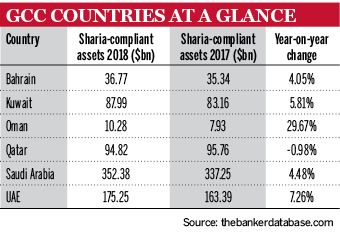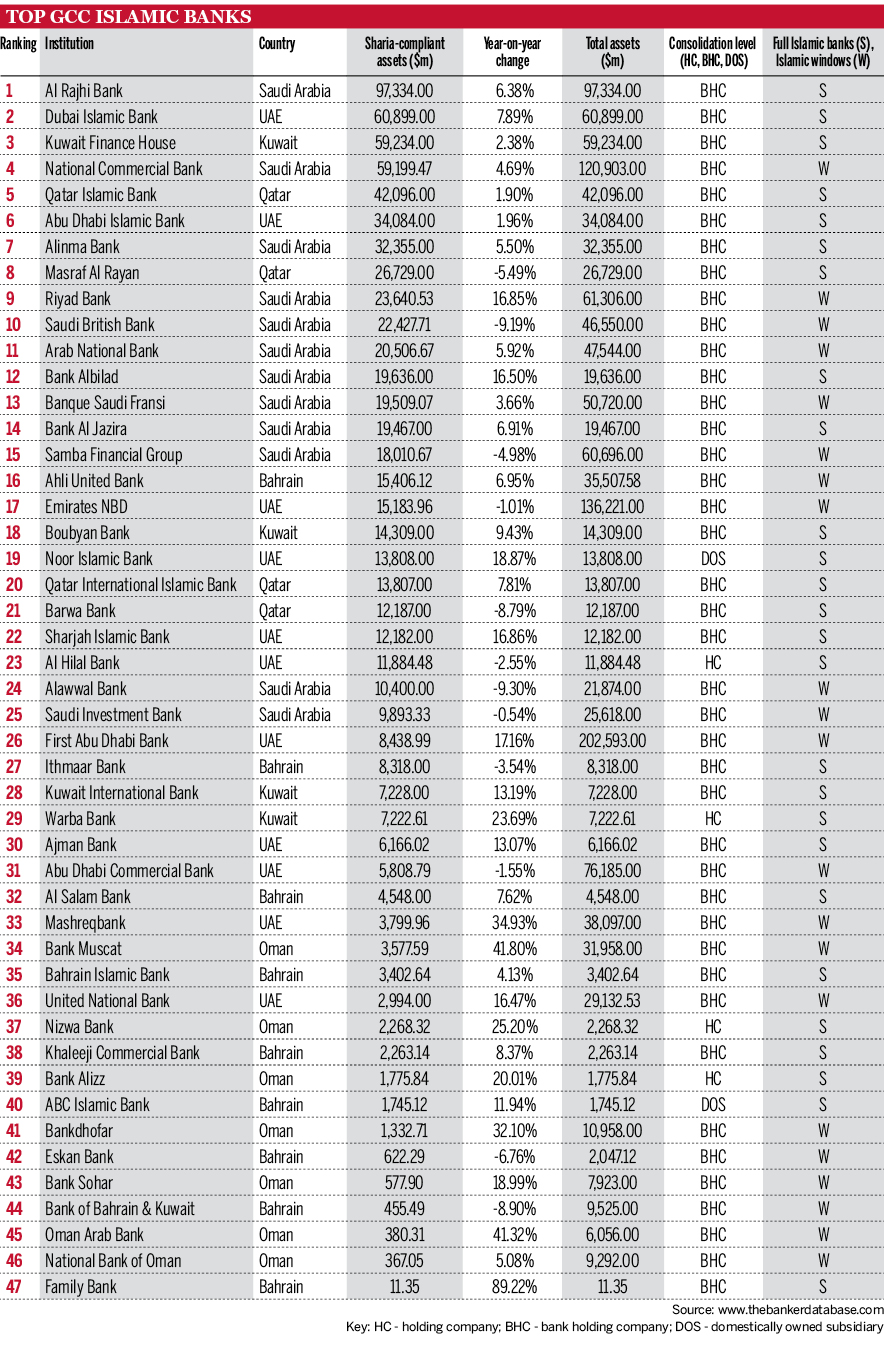The Banker's Top Islamic GCC Banks ranking 2020: Saudis dominate a healthy picture
The Banker's Top Islamic GCC Banks ranking shows that despite uncertainty over the future of oil revenues, the region's Islamic banks continue to chalk up impressive numbers for assets, profits and capitalisation. John Everington reports.
The Gulf Co-operation Council’s (GCC’s) Islamic banks continue to post impressive growth amid often challenging economic conditions in their home markets. The bloc’s six countries have all enacted significant economic and social reforms in recent years, as uncertainty over future oil revenues acts as a brake on consumer spending and key economic sectors.
Despite such challenges, the region’s 47 Islamic banks are in rude health in terms of asset growth, profitability and capitalisation. The Banker’s Top Islamic GCC Banks ranking for 2020 shows that sharia-compliant assets across the region grew by 5.2% in 2018, compared with a growth of 4.1% for total assets – both conventional and Islamic – over the same period.
The growth in demand for sharia-compliant services across the region coincides with significant consolidation within the financial services sector, with Islamic banks proving no exception. The resulting wave of mergers and acquisitions is set to give birth to a series of Islamic finance giants, which is likely to further spur the take up of such services.
Saudi dominates
While financial institutions in Kuwait and the United Arab Emirates have notched up impressive growth, Saudi Arabia remains the dominant Islamic banking market on both a regional and a global level. Saudi banks make up 10 of the 15 largest banks across the region in terms of sharia-compliant assets, and account for nearly half of its sharia-compliant asset base.
Al Rajhi Bank remains the dominant Islamic bank within both Saudi Arabia and the wider region, with its significant growth of the past few years showing no signs of slowing. The Riyadh-headquartered institution’s asset base grew 6.4% to $97.3bn in 2018, accounting for 12.8% of the region’s overall sharia-compliant assets. Al Rajhi’s profitability and return on assets are still among the highest in the region, even as Tier 1 capital fell as a result of zakat back payments, a cost borne by the majority of Saudi banks.
Information sourced from The Banker Database – which includes conventional banks – indicates that over the 2018 review period, Al Rajhi Bank came in at number one for Saudi Arabia in terms of return on capital and return on assets, which reached 21.21% and 2.82%, respectively. This compares with a country average of 14.02% and 2.21% for the same period.
The bank continues to expand in key sectors such as housing, education, healthcare and renewable energy, strengthening its structured finance team and seeing increased levels of activity in large projects. Al Rajhi’s home financing grew 39% in the 12 months to the end of June 2019, with double-digit growth expected in the coming two to three years.
Al Rajhi’s results suggest its position at the top of The Banker’s ranking is unlikely to be overhauled any time soon, with its sharia-compliant asset base nearly 60% larger than its nearest rival. Yet the region’s other major players have strong ambitions of their own, marrying strong organic growth with potentially game-changing mergers and acquisitions.
DIB moves up
The most noteworthy move within the upper echelons of The Banker’s ranking for 2020 is the stellar performance of Dubai Islamic Bank (DIB). The UAE’s fourth largest bank by assets overtook Kuwait Finance House (KFH) to become the region’s second largest Islamic financial institution in 2018. Its sharia-compliant asset base grew 7.9% during the review period to $60.9bn – the highest percentage growth registered in the top five.
DIB has enjoyed surging market share in the UAE, growing from 4.8% in 2013 to 9% in September 2019 in terms of net financing assets, according to Moody’s Investor Service, with a presence in six international markets including Indonesia, Pakistan and Turkey.
The bank’s rising market share in the UAE reflects growing demand for sharia-compliant services in the country from both Islamic and conventional lenders. Assets grew by 7.26% during 2018, a noteworthy rise for a country considered to be one of the region’s more developed Islamic finance markets.
Six of the country’s 11 banks posted a double-digit rise in sharia-compliant assets for the year, including three conventional financial institutions. Of the latter, Mashreqbank (one of the country’s oldest financial institutions) had a particularly good year as its (albeit comparatively small) sharia asset base grew 34.9% to $3.8bn.
Coupled with DIB’s organic growth is the bank’s acquisition of local Islamic rival Noor Bank. The move, first announced in June 2019, was formally completed in January 2020, marking the latest in a series of mergers in the region’s crowded banking sector. The newly merged entity is set to have $75bn-worth of sharia-compliant assets, further boosting DIB’s stature both in the UAE and abroad.
Super banks in wings
A similarly sized super lender is set to be created by the acquisition of Bahrain’s Ahli United Bank (AUB) by KFH, one of the region’s oldest Islamic finance institutions. Following long-running discussions, in January 2020 KFH shareholders approved the acquisition of AUB, the first cross-border banking tie-up in the region in recent years. The move will create an entity with more than $100bn in total assets, about $75bn of them sharia compliant. KFH posted a 2.4% rise in its sharia-compliant asset base in 2018.
While ostensibly a merger of two conventional banks, the merger of Saudi British Bank (SABB) with fellow Saudi financial institution Alawwal Bank, completed in June 2019, creates an entity with $38bn in sharia-compliant assets, according to 2018 figures, making it the region’s sixth largest Islamic bank.
One merger that seems to have fallen through, though, is that of Saudi Arabia’s National Commercial Bank (NCB) and Riyad Bank, the highest placed conventional financial institutions in this year’s top 10. NCB, Saudi Arabia’s largest bank by assets, ended long-running merger talks with Riyad in December, ending the prospect of another regional giant with more than $75bn in sharia-compliant assets. Riyad Bank is the strongest gainer in this year’s top 10, posting a 16.9% rise in sharia-compliant assets, and overtaking SABB to claim the number nine spot.
Sharia institutions lead
Full sharia banks dominate the rankings for 2020 as they did in 2019, with conventional banks with Islamic windows accounting for just three of the top 10 and one of the top five largest banks in the region. Full Islamic banks experienced slightly faster growth during the year, accounting for 68% of the region’s sharia-compliant assets, in line with last year’s figures.
Of the 47 banks in this year’s ranking, 12 posted a drop in assets over the 12-month review period, though only six registered a drop of more than 5%. Qatar banks had the most challenging year asset-wise in 2018, with sharia-compliant assets falling by 1% year on year, as the country’s financial institutions adjusted following the introduction of IFRS 9 at the start of that year.
The sharia-compliant asset base of Masraf Al-Rayan, the country’s second largest Islamic bank, declined by 5.5% during the year to $26.7bn, and Barwa Bank posted an 8.8% drop. At the other end of the spectrum, Qatar Islamic Bank and Qatar International Islamic Bank both saw their asset bases rise during the year.
Islamic banks in Oman registered the most notable growth in sharia-compliant assets in the region during the year, reflecting the country’s status as the smallest Islamic finance market in the GCC by some distance. Added together, Oman’s seven lenders account for less than 2% of the region’s total sharia-compliant asset base. All but one of the country’s seven banks registered double-digit growth during the year, with its largest lender, Bank Muscat, leading the way with a 41.8% rise.
The Banker’s second ranking of the GCC’s Islamic commercial banks confirms that the sector remains in good health despite challenging economic conditions. Even though the sector is among the world’s most settled and mature Islamic banking markets, growth remains strong, especially in the established markets of Saudi Arabia and the UAE. Expect this trend to continue in the coming years, especially with the emergence of a new class of super banks.




